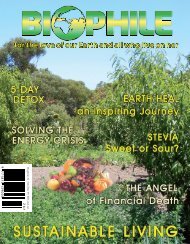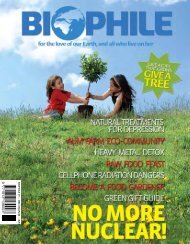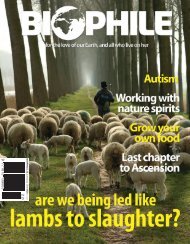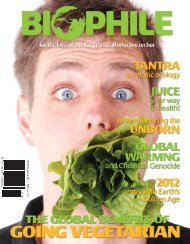BIOPHILE 16 â JUNE/JULY 2007 R25 - Biophile Magazine
BIOPHILE 16 â JUNE/JULY 2007 R25 - Biophile Magazine
BIOPHILE 16 â JUNE/JULY 2007 R25 - Biophile Magazine
- No tags were found...
You also want an ePaper? Increase the reach of your titles
YUMPU automatically turns print PDFs into web optimized ePapers that Google loves.
turbed for 10 minutes, then stir in thelemon juice.Serve immediately.Kichadi — rice and mung beanmixture(Two servings)8 cup water1½ cup white basmati rice½ cup yellow split mung bean½ tsp cumin seeds2 tsp pure ghee¼ tsp powdered rock salt½ tsp coriander seedsBring the water to boil in a large stainlesssteel pot. Wash the rice and beansand add to the boiling water, alongwith salt.Cover and simmer on medium low heatfor 25 minutes.In a small cast-iron skillet, roast theseeds for a few minutes over the heat,until they are golden brown. Grindthem into coarse pieces, using a mortarand pestle.Heat the ghee in the same skillet andadd the crushed seeds. Sizzle for 2minutes, and then pour into the riceand beans mixture.Cover and continue cooking on lowheat for another 10 minutes. Removefrom heat and let the Kichadi sit for 10minutes before serving.Wheat-Date Porridge(Two Servings)6 cup water1 cup whole wheat kernels¼ cup raisins¼ cup pitted dates½ tsp orange zest½ tsp cinnamon powder½ tsp cardamom powder1 cup milkBrown sugar according to tasteBring the water to boil in a heavy stainlesssteel pot. Wash the wheat kernelsand add to the boiling water, alongwith raisins, dates, orange zest andspiced powders.Stir, cover, and let simmer over medium-lowheat for 1 hour.Then add the milk, sugar, and vanillaessence. Stir, cover, and continue tocook over low heat for an additional30 minutes. Add water, if necessary,to prevent the porridge from sticking.Serve warm or cool.Ama-reducing dalPreparation time: 3 days to sprout the mung,30 minutes to 1 hour to make soup.Serves 5 -6In a pressure cooker put:2 -3 cups sprouted mung beans.2- 4 cups waterBring to pressure and cook for about 2minutes. Or cook the beans and waterin a covered saucepan until soft. Blendthe beans and cooking liquid in ablender.Set aside.In a stainless steel soup pot, warm:1 ½ tsp. ghee or olive oilAdd: 3-5cm fresh ginger root, peeledand chopped1-3 cloves of garlic, minced (omit if youhave high Pitta)1-2 – 1 tsp cumin seeds1 tsp coriander seeds½ - 1 tsp turmeric½ tsp. freshly ground black pepper2-3 bay leaves1/8 tsp. each of fennel seeds, cinnamon,and cardamomToss until coated and their aromasemerge. Add to the spices and oil.2-3 cup. chopped vegetables (broccoli,carrots, greens, sprouts, green beansor asparagus work well)Toss until coated. Stir for two minutes,and then add 4-6 cups additional waterMix well. Bring to a boil, then reducethe heat and simmer covered until veggiesare cooked.Add pureed mung beans to soup pot.Bring to a boil again. Reduce heat andlet soup simmer for 5 minutes. Addmore water if a thinner consistency isdesired. Add:½ tsp salt, or to taste.Serve it warm.Uses of ghee in winterThe cow is revered in India as a sacredbeing. Her milk and her butter, clarifiedas ghee, are like mothers in Ayurveda,absolutely essential for health and wellbeing. They must be pure to do this.Many westerners are concerned that theuse of ghee will increase their cholesterolor add unnecessary amounts of fat totheir diet. Used with in context of anAyurvedic lifestyle, this is a quite unlikelyto occur. If abused, it could.To explain: ghee, unlike butter, helpsto stimulate the healthy flow of fluidsthroughout the body. Butter can congest;ghee removes blockages. No othersubstance stimulates the flow of bodilyfluids as ghee does. Cold- pressed oliveoil is specific for stimulating the flow ofbile from the liver and gall bladder andthereby reliving congestion there. Butghee does this throughout the body.At the same time, ghee strengthensOZA, our vital energy cushion, which is atthe root of our well- being and immunity.Through OZA, ghee nourishes immunityas well, the fire of our minds. In thisway, intelligence, energy, confidence,understanding, and memory areenhanced.It is important to understand that gheeis given and taken within the contextof an Ayurvedic program. Usually thefortunate and wise person will do detox,at the change of seasons or whenever it isrecommended. This, in conjunction witha healthy lifestyle, will ensure arelaxedbalance, inner and outer. And yet thiswhole lifestyle is new to us to a certainextent, as westerners. Adding a littleghee to our rice, kichadi, or steamedvegetables, or hot fresh milk, is likely tohelp us. Adding ghee to our frozen foodentrée is unlikely to do so. Making richdeserts daily with ghee is also unlikelyto have the desired effect. We must useit with common sense and prudence,within its context.As always, this is up to us.Dr Ram Garg BAMS, MD Indiaruns his Ayurveda Centre at 5 Clifton Road,Muizenberg and a monthly Ayurved Clinic inFourways, Johannesburg.Practice No: 10400002188045 Clifton Road, Muizenberg021-7883435/0828528084Or Email: ram_ayurveda@yahoo.com<strong>Biophile</strong> Issue <strong>16</strong>51
















